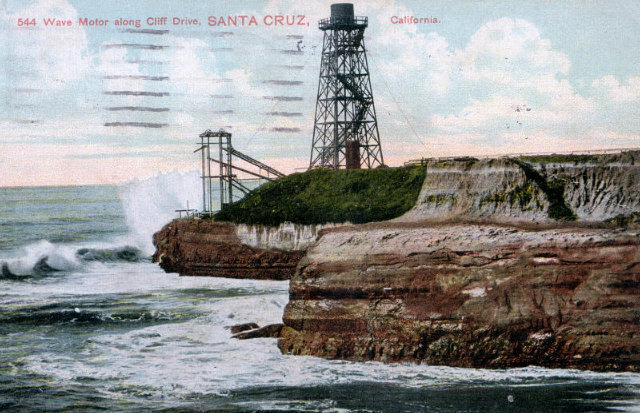

A Postcard depicting the Santa Cruz Wave Motor. The photograph was taken by Charles Weidner of San Francisco, CA. The card was printed in Germany.
The Santa Cruz wave motor was written up in Scientific American magazine on January 4, 1902. Here is the text of that article:
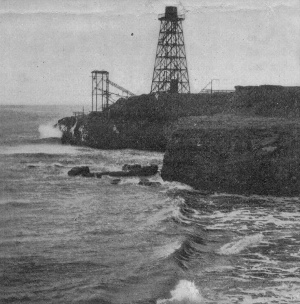

|

Ever since man first sought to render useful the various forces of nature the wonderful power in the mighty waves of the ocean has excited his awe and exercised his ingenuity. Fortune after fortune has been expended to carry out the carefully calculated plans of the mechanical engineer or the fancy of the sanguine theorist. A few have worked: stockholders were elated, the inventor hilarious; but soon the sea arose in wrath, restraints of wood, cement or steel were but playthings before the storm, and by morning the contrivances of man lay a crumpled wreck upon the beach. The city of Santa Cruz, California, owns what is perhaps the only practical and efficient Wave motor in existence to-day, and it has stood the test of four years' operation. One of the many attractions of Santa Cruz is the Cliff Drive, extending for four miles northerly from the city along the ragged sandstone bluffs rising in places sheer fifty feet from the breakers below, tunneled and worn by the ceaseless swell of the open Pacific. At a point unprotected by outlying rocks or shoals two wells eight and five feet in diameter respectively were sunk in the cliff, one behind the other, the foremost but five feet from the brink. These wells extended from thirty feet above high tide to below the ebb and opened at bottom in the ocean. The simplicity of the motor precludes a lengthy description. A counterbalanced float rises and falls between vertical guides in the foremost well as the swells outside raise or lower the water level. The plunger of a common force pump working in any part of a long pump barrel occupies the second well, forcing on the down stroke the salt water vertically 125 feet to a 5,000-gallon tank raised on a 60-foot derrick on the bank above, from whence it runs to tanks along the country roads for miles around and is used for sprinkling purposes. In ordinary weather the pump fills the supply tank in about one hour. The surplus will also shortly be utilized in the manufacture of salt. But to return to the motor. A 35-foot four-post derrick carries the vertical guides for pump and float which are fastened at and near the outer end of a 12 inch round timber 60 feet in length, the butt counterbalanced on the bank over two small iron car wheels rolling on a short track, and thus allowing the timber to recede and advance as well as to oscillate as its outer end follows the vertical guides. The stopping and starting contrivance, however, caps the climax for simplicity. A strong chain leads from the outer end of the beam above the float over two shelves at the top of the derrick and suspends a large barrel in vertical guides at the side. To stop the motor the barrel is filled with water from a short garden hose attached to a convenient connection from the tank. The weight of the filling barrel gradually overbalances the float, raising it above the waves. When the motor is to start a plug is pulled from the bottom of the barrel and the float gradually goes into action.
|
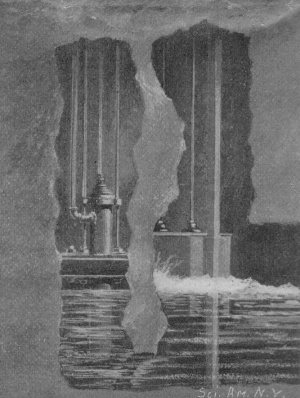
|
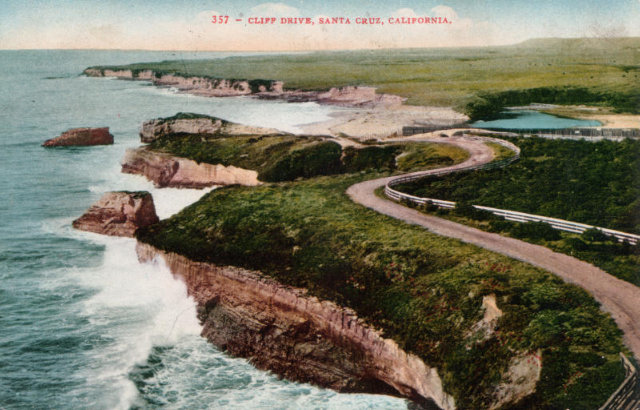
There is little remaining evidence of the wave motor. The relentless pounding of the surf is slowly removing the remaining physical traces of the installation. Below, two aerial photos show the site in 1979 and then later in 2004. In 1979 the twin shafts are still clearly visible. In 2004 the seaward shaft has been breached but you can still see the curved surface of its bore. Sometime after this photo was taken a cover was installed over the remaining shaft.
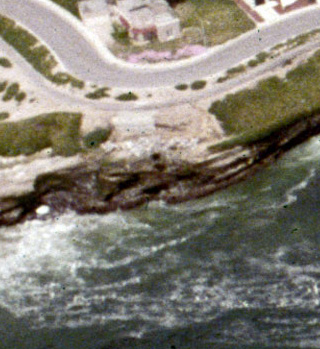 |
 |
Sandy Lydon's page on the Wave Motor (Recommended)